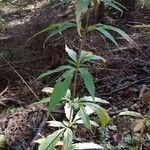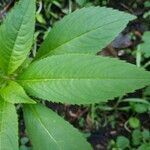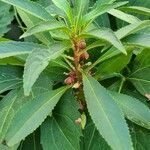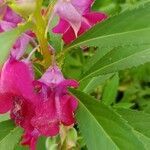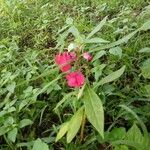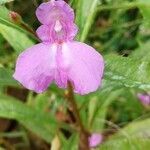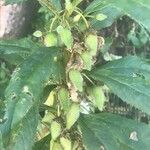Annual herb to 60 cm. tall, often less; stem ± erect, simple or sparsely branched, glabrous or pubescent when young.. Leaves spirally arranged, the lowermost occasionally opposite; petiole 2–13 mm. long; lamina narrowly lanceolate to narrow-elliptic or oblanceolate, 2.7–9 cm. long, 1.1–2.6 cm. broad, the base cuneate, the apex acute, glabrous or finely pubescent above and/or beneath; lateral veins 4–7 pairs; margin serrate-dentate with several dark ± sessile glands towards the base of the lamina.. Flowers epedunculate, solitary or in fascicles of 2–3, white or pink.. Bracts linear-lanceolate, ± 2 mm. long, inconspicuous.. Pedicels 1–1.6 cm. long, slender, glabrous or pubescent, spreading in flower but becoming pendent in fruit.. Lateral sepals 2, narrowly ovate-lanceolate, 2–3 mm. long.. Lower sepal deeply navicular, 1.3–1.9 cm. long, 0.4–0.8 cm. deep, abruptly constricted into a 1.3–2.4 cm. long filiform spur, incurved in the distal half, glabrous or finely pubescent throughout or or in part.. Dorsal petal 1–1.4 cm. long, 0.7–1.1 cm. broad, cucullate, apically produced into a 2–4 mm. long pointed appendage.. Lateral united petals 2.3–3.5 cm. long; upper petal of each pair about one-third the size of the lower, oblong, 9–10 mm. long, 7–9 mm. broad; lower petal of each pair suborbicular, 18–27 mm. long, 18–25 mm. broad, unevenly bilobed.. Ovary densely pubescent.. Fruit broadly-fusiform, 12–20 mm. long, 6–8 mm. broad, densely pubescent.
Annual, 3–8 dm, ± pubescent; lvs oblanceolate, 6–15 cm, sharply serrate, gradually tapering to the short petiole; pedicels 1 or 2 in an axil, 1–2 cm, 1-fld; fls purple or rose, varying to white, the pet 2–2.5 cm, the saccate sep wider than long and shorter than the spur; fr villous; 2n=14. Native of s. Asia, widely naturalized in the tropics, and occasionally escaped from cult. in our range.
Annual, 3–8 dm, ± pubescent; lvs oblanceolate, 6–15 cm, sharply serrate, gradually tapering to the short petiole; pedicels 1 or 2 in an axil, 1–2 cm, 1-fld; fls purple or rose, varying to white, the pet 2–2.5 cm, the saccate sep wider than long and shorter than the spur; fr villous; 2n=14. Native of s. Asia, widely naturalized in the tropics, and occasionally escaped from cult. in our range.
An annual plant. It has a bushy habit. It grows 60-75 cm high and 35-45 cm wide. It has a few branches. The flowers are cup-shaped and hooded. They are 2.5-5 cm across. They can be pink, red, purple or white. The pods burst open when touched.
